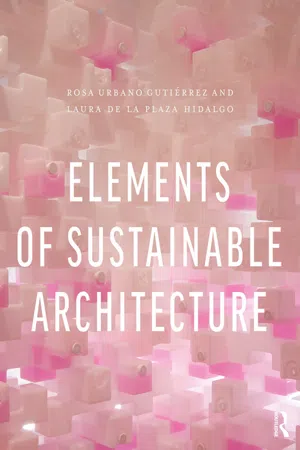INTRODUCTION TO NATURAL ELEMENTS
The human body is in continuous exchange with its surrounding environment. Solar radiation provides the heat and light essential for our existence, being a critical factor for our well-being at the physiological, psychological, and emotional levels. We exchange heat with our environment via radiation, convection, conduction and evaporation. Our bodies need oxygen from the outside air and water to release energy via cellular respiration. Water, plants and animals provide the essential nutrients and catalyse the processes that provide energy, maintain life or stimulate growth. And the soil provides the structure to support life and human activities, being a medium for food and other biomass production, as well as for water storage, supply and purification; an essential source of carbon and raw materials; a habitat for organisms; and a platform for landscape, culture and socioeconomic activity.
A sustainable perspective would regard architecture as an extension of our bodies, displacing an approach to the built environment as a static shelter to protect us from the weather and other external threats and moving toward permeable structures that should aim to allow the same exchange our bodies need in a balanced and healthy way. Buildings can therefore be considered an extension of our skin, senses and receptors, as the element that filters, buffers or regulates those interactions. It is fundamental to think about a building as a dynamic entity that is an integral part of a site.
A building interacts with the natural environment as a material physical structure, as well as a living structure undertaking and sustaining dynamic processes: it is a place where people develop their activities, using devices that consume energy, for which internal environments are generated to provide human comfort or to suit those activities.
As a physical structure, the building can be made of inert and living materials that form its different parts. As a living structure, the building also exchanges materials and energy with its site while it is used during its lifetime, requiring inputs such as energy or water and producing outputs such as waste and pollution. Traditionally, buildings have used various natural resources in a linear way: taking what was needed and releasing their waste. Today we understand that, to achieve global sustainability, our buildings have to work in the same way nature does: using cyclical systems. Making built habitats work in the same way as natural habitats means that they have to be evaluated based on their flexibility and ability to adapt to present and future changes, establishing symbiotic relationships with the natural system instead of subjugating it. It is important to understand the intrinsic relationships with which natural phenomena are deployed and then how we position ourselves and establish our own relationship with that biological environment.
It is therefore fundamental to consider the role of the five natural elements that are vital to us (air, earth, living beings, sunlight and water) in our buildings. As architects, we need to learn how to take advantage of their benefits and deal in the best possible way with the aspects that represent a disadvantage for our health and well-being. One of the main characteristics of the natural elements is their dynamic condition, showing different patterns depending on geographical location, season and daily cycle. These characteristics are mainly grouped and classified according to the different climates defined for the regions of our planet.
Providing a good use of the natural elements in our building design implies a proper understanding of the regional climate in general, as well as a careful analysis of the local characteristics in particular of the building’s site. The climate of a location is affected by latitude, terrain and altitude, nearby vegetation and water bodies.
We can design efficiently with natural elements either passively or actively. Passive (climate-responsive) design involves using natural elements as energy sources, reducing or eliminating the need for lighting, heating or cooling systems that require energy consumption, as well as working with architectural means (i.e. building form and components) to provide the desired comfortable indoor conditions. Active design involves design strategies that consume energy. An active sustainable design should be mindful of our finite natural sources and propose instead the use of renewable energy sources (i.e. sun, wind, geothermal).
The aim of this chapter is to assist readers in the acquisition of knowledge about both types of design strategies, passive and active. The design process must include asking questions about the relationships among the various natural elements, site conditions and building use, integrating architecture, landscape or physical contexts, and environmental techniques. The design process is informed by questions about the physical reality of the building site, for example, how is the wind pattern, and what effect will it have on occupants’ comfort? How can I arrange my buildings’ layout to optimise natural ventilation or sunlight exposure? Can my rainwater storage strategy be part of my landscape design? What is my land availability and its potential for geothermal energy? Or how do I select and arrange vegetation around my building, keeping the user’s comfort and energy savings in mind?
This chapter presents a total of 19 Design Elements, organised according to five groups or sections: ‘Designing with Earth’, ‘Designing with Living Elements’, ‘Designing with Air’, ‘Designing with Sunlight’ and ‘Designing with Water’. Given the relevance of the physical context, in this chapter, the ID pages include two more sections to the general ‘What Is …?’, and ‘Life Cycle Assessment and Environmental Profile: Design Factors Table’ and ‘What Makes a Site Good for … Design?’ These two extra sections allow for further clarific...
